

|
|
Searching for Answers to Topical Planning Questions: Capitalizing on the Resources of the World Wide Web |
. |
|
Wayne M. Senville and Dean L. Pierce
|
Author Info |
|
EDITORS NOTE: This article is only one of several excellent presentations made by Pierce and Senville. Fortunately, the Planning Commissioners Journal host online versions of these presentations, including the one related to this article, on their Planners Web site. These can be found at http://www.plannersweb.com/tour/apa98.html. These online article provide an excellent overview of how the internet is being used by "real" planners and includes A Tour of the Internet: A Dozen Key Sites for Citizen Planners and Planning Departments and Commissions Using the Web to Provide Information to Constituents. They include tons of online examples and candid and insightful comment from planners actually using the internet. |
Imagine you are a Planning Commissioner in a small city with very limited planning staff. You and your colleagues are currently updating the City's Master Plan and want to learn more about the fiscal impacts that result when large retailers such as Wal-Mart locate outside existing downtowns. Because you have a computer and modem, someone suggests you try searching for this information on the Internet. You are willing to try, but are skeptical that the "world wide web" could be used to gather information helpful in answering such planning questions. With help from a friend you go online -- and are surprised by the results.
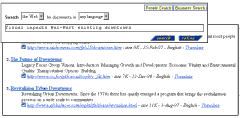
Click on the figure to see a larger version, or Go to the actual site at http://www.altavista.digital.com Figure 1 Alta Vista Search Engine Query |
Many people start to look for information on the world wide web (Web) by using "search engines." Search engines are special web sites that function much like the card catalogs found in libraries. Typical search engines allow users to enter key words, phrases, or complete questions, which are then compared against vast databases. These databases, which are constantly being updated, contain references ("links") to web pages and other information resources located all over the Internet. See Figure 1, which illustrates a search for information (and a portion of the results) addressing the fiscal impacts of Wal-Mart.
The primary advantage of using a search engine is its ability to locate large amounts of relatively useful material quickly, easily, and inexpensively (in fact, most generalized search engines may be used free of charge, as they are underwritten by advertisers). For all types of users, search engines help bring order to a reservoir of information that is both massive and chaotic. The primary advantage of search engines is also their primary disadvantage, however. Unless users exercise considerable care when choosing key words or other selection criteria (which produces a "narrow" search), search engines can locate overwhelming quantities of links. Another limitation of many search engines is that they cannot evaluate the validity of information contained in the various web sites to which users are referred.

Click on the figure to see a larger version or go to the actual site at http://www.bossnt.com/596/walm31.html. Figure 2: Beliot Daily News Article |
A successful query of a search engine can help users find pertinent information from a variety of sources. Figure 2 illustrates a Beloit, Wisconsin, newspaper article summarizing research by Iowa State University Professor Kenneth Stone. This research reveals that the construction of very large retail establishments can have both positive and negative impacts.
Figure 3, from a site maintained by the University of Wisconsin Extension Service, presents additional information on Wal-Mart impacts, including a list of the types of businesses most likely to lose sales as well strategies business in a community may use to increase their competitiveness. Again, both of these sites were located by using a general search engine.
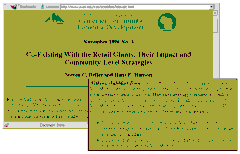
Click on the figure to see a larger version or go to the actual site at http://www.uwex.edu/ces/cced/lets/letswalc.html. Figure 3: University Of Wisconsin Extension Service Page |
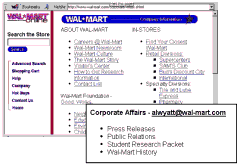
Click on the figure to see a larger version or go to the actual page at http://www.wal-mart.com/corporate/. Figure 4: Wal-Mart Corporate Web Page |
A search engine also readily found the location of Wal-Mart's own web page. As shown in Figure 4, Wal-Mart's corporate web site supplies phone numbers and other contact information, as well instructions on how to request a Wal-Mart research packet.
Currently, the most comprehensive Web search site for planning information is known as Cyburbia -- sponsored by the SUNY Buffalo, School of Architecture and Planning and maintained by Dan Tasman. See Figure 5. Cyburbia functions primarily as an on-line directory of other planning-related sites and documents available on the Web. See Figure 6. Cyburbia itself contains little original material (though it does host active discussion forums, noted later).
http://www.cyburbia.org
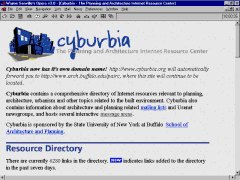
Click on the figure to see a larger version or go to the actual page at http://www.cyburbia.org . Figure 5: Cyburbia Web Page |
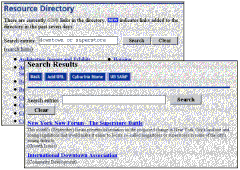
Click on the figure to see a larger version or go to the actual page at http://www.cyburbia.org . Figure 5: Search of Cyburbia Resource Directory |
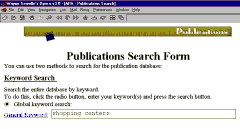
Click on the figure to see a larger version go to the actual page at http://www.planning.org/scripts/apapubs/pubsearch.asp . Figure 7: APA Web Site Keyword Search |
![]()

Click on the figure to see a larger version. Figure 8: Search Results |
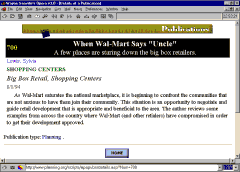
Click on the figure to see a larger version. Figure 9: Summary of Publication Listed Search Results |
Maintained by the Planning Commissioners Journal, the Planners Web provides a variety of articles on-line, as well as links to other planning-related resources. See Figure 10. Using our example, a search of the Planners Web for references to "wal-mart" yielded a page from one of the Planners Web's "What' New" columns that included a section providing links to several Web sites involving Wal-Mart. See Figure 11. [Note: the authors of this article are both affiliated with the Planners Web and Planning Commissioners Journal].
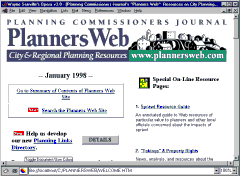
Click on the figure to see a larger version or go to the actual page at http:www.plannersweb.com . Figure 10: Planners APA Web Site |
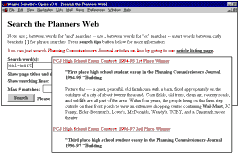
Click on the figure to see a larger version or go to the actual page at http:www.plannersweb.com/search.html. Figure 11: Planners Web Search Results |
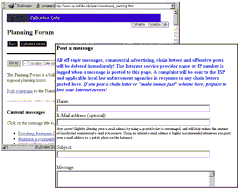
Click on the figure to see a larger version or go to the actual page at http://www.arch.buffalo.edu/pairc/wwwboard_planning.html. Figure 12: Planning Forum at Cyburbia |
While traditional Web sites are tremendous resources, they are limited to the information that their creators have presented in them. Electronic discussion areas, in contrast, are dynamic and can yield detailed answers to your specific questions and requests. Think of them as rooms where large numbers of people knowledgeable about nearly every aspects of planning gather on a regular basis.
The thousands of electronic discussion areas available today fall into four main categories: newsgroups; Internet mail lists; bulletin boards and Web-based discussion areas/forums; and forums available on commercial services such as CompuServe and America On-Line. While each category has its own quirks and requirements, a feature common to all is the ability to receive and distribute information -- in the form of messages -- among large numbers of people. See Figure 12, which illustrates the online planning forum found at the Cyburbia web site.
The Internet -- and most particularly the World Wide Web -- offers a rapidly growing wealth of information to assist communities in dealing with many of the planning issues they face. At the same time, it must be borne in mind that much information is not available on the Web. To rely exclusively on Web searches is to miss valuable information available only in print. In addition, researching on the Web can be time consuming, especially when general search engines are used, since large amounts of irrelevant material will be generated (unless care is used in selecting key words).
One of the unique functions of the Internet is the ability of a researcher to post questions in on-line forums, newsgroups, and mailing lists. This allows the researcher to quickly tap into a wide network of individuals who may be able to offer leads or relevant information. At the same time, it can sometimes be difficult to evaluate the reliability of information provided by people who may offer help.
Wayne M. Senville, Editor
Planning Commissioners Journal
Dean L. Pierce, Assistant Editor
Planning Commissioners Journal